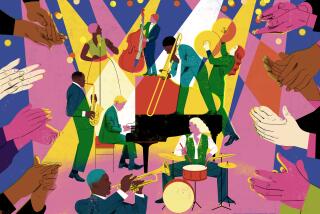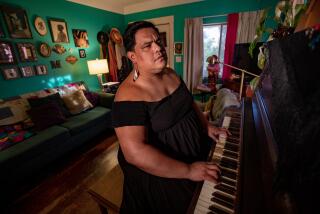JAZZ REVIEWS : Differences Keep Them Together : The pairing of guitarists Ron Eschete and Joe Diorio makes for moments of great interaction at the show at El Matador.
- Share via
HUNTINGTON BEACH — When two guitarists of the caliber of Ron Eschete and Joe Diorio get together, you expect sparks to fly. That’s exactly what happened at El Matador on Thursday, when the pair, backed by bassist Luther Hughes and drummer Ted Hawk, compared and contrasted styles in a charged set of jazz standards.
The show was a reunion of sorts for Eschete, Hughes and Hawk, who now lives in Paris. The three used to play with vibraphonist Dave Pike at the now-defunct Hungry Joe’s here on Pacific Coast Highway in the early ‘70s. Maybe this bit of shared history accounts for the empathy the two-man rhythm section showed to the front line, especially Eschete.
Diorio and Eschete share certain similarities. Both have paid their share of dues: Diorio with such people as Sonny Stitt, Eddie Harris and Stan Getz; Eschete with Pike, Milt Jackson and Ray Brown, among others. Both are longtime instructors at Hollywood’s Guitar Institute of Technology, and both are considered innovators who are loaded with technical skills.
But on the bandstand, it’s their differences that are most apparent. Eschete pulls fluid lines and chord-rich improvisations from his seven-string instrument, and no beat remains unturned. Diorio takes a looser approach, stringing together pointed, single-note runs that bounce around the scale--and sometimes the rhythm--with an angular intensity. The combination of the two sounds made for moments of melodious counterpoint as well as uneasy attachment.
The opener, “I Remember You,” established the evening’s format with Diorio stating the theme above Eschete’s propulsive accompaniment. During his solo, Diorio ran with the melody while inserting octave-wide jumps and moments of sudden acceleration. Eschete took an insistent, lyric tack, sailing cleanly between sparkling, single-note phrases and rich, extended chordal passages.
Hughes backed this creative bit of play with a steady walk from his electric instrument while Hawk, working without benefit of a high-hat cymbal, pushed the tune along with a steady pulse from his ride cymbal. The number closed with an exchange of lines, with the two guitarists sometimes competing for attention against each other’s play.
The quartet continued this approach through a blues number, the traditional “O Tannenbaum” (which featured Hawk’s lively brush work) and a pair of Bronislaw Kaper tunes, “On Green Dolphin Street” and “Invitation.”
At one point during the set’s closer, a fast-paced version of Sonny Rollins’ “Oleo,” Hughes and Hawk suddenly stepped aside, leaving Eschete and Diorio to their own devices. They stumbled for a moment until Eschete whipped up a chordal pulse for his partner to stand on, and the two took off on a sometimes atonal exchange that saw them impatiently jumping on top of one another’s lines, a standoff that made for one of the evening’s most exciting moments.
More to Read
The biggest entertainment stories
Get our big stories about Hollywood, film, television, music, arts, culture and more right in your inbox as soon as they publish.
You may occasionally receive promotional content from the Los Angeles Times.










